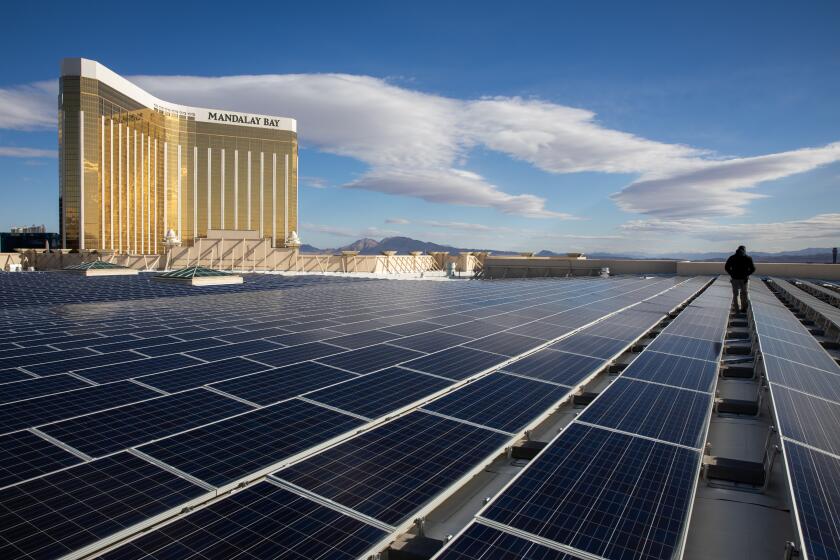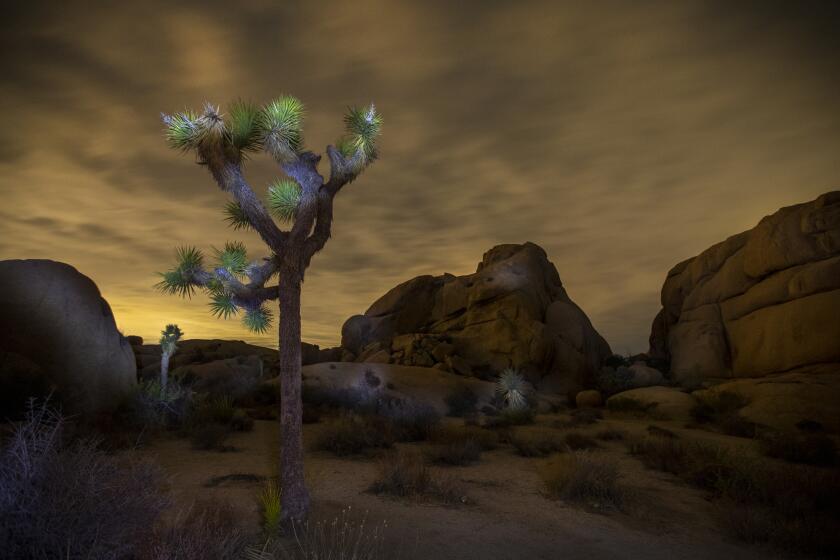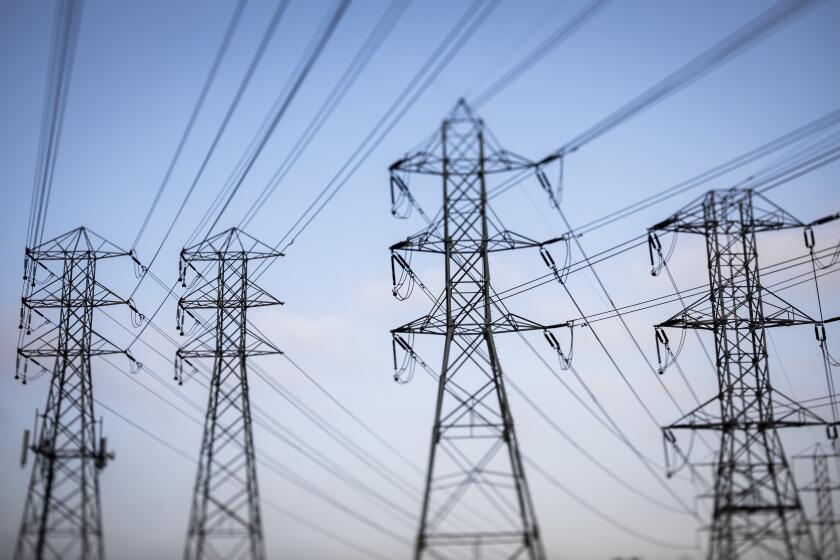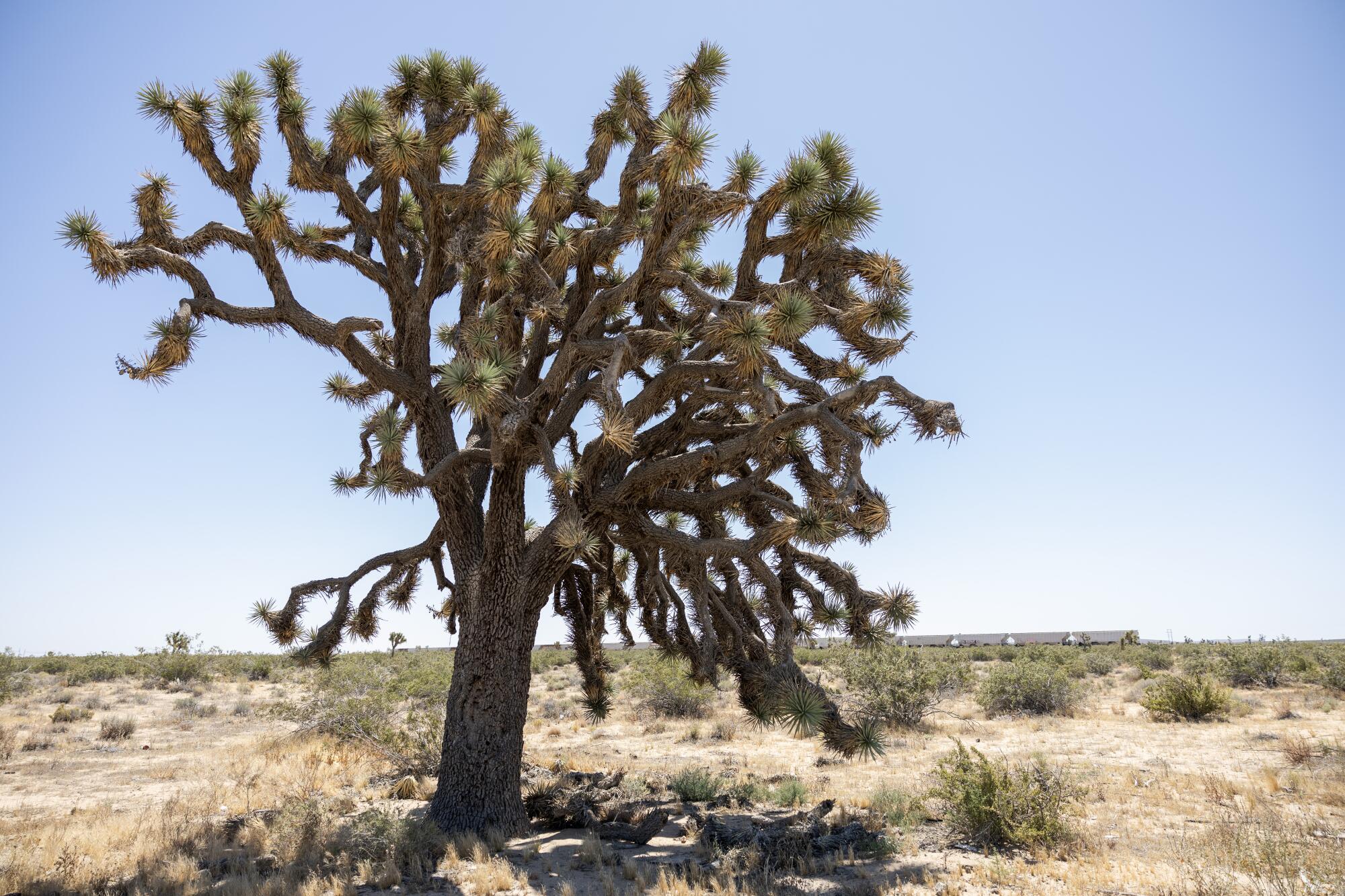
- Share via
BORON, Calif. — A renewable energy company will soon begin clearing thousands of protected Joshua trees just outside this desert town, including many thought to be a century old, to make way for a sprawling solar project that will generate power for 180,000 homes in wealthier coastal neighborhoods.
The 2,300-acre project has angered residents of Boron and nearby Desert Lake, two small Kern County towns where the poverty rate is twice the California average. Residents say their concerns about construction dust, as well as the destruction of the mostly pristine land that is habitat for endangered desert tortoises, have been ignored by the county and state officials who approved it.
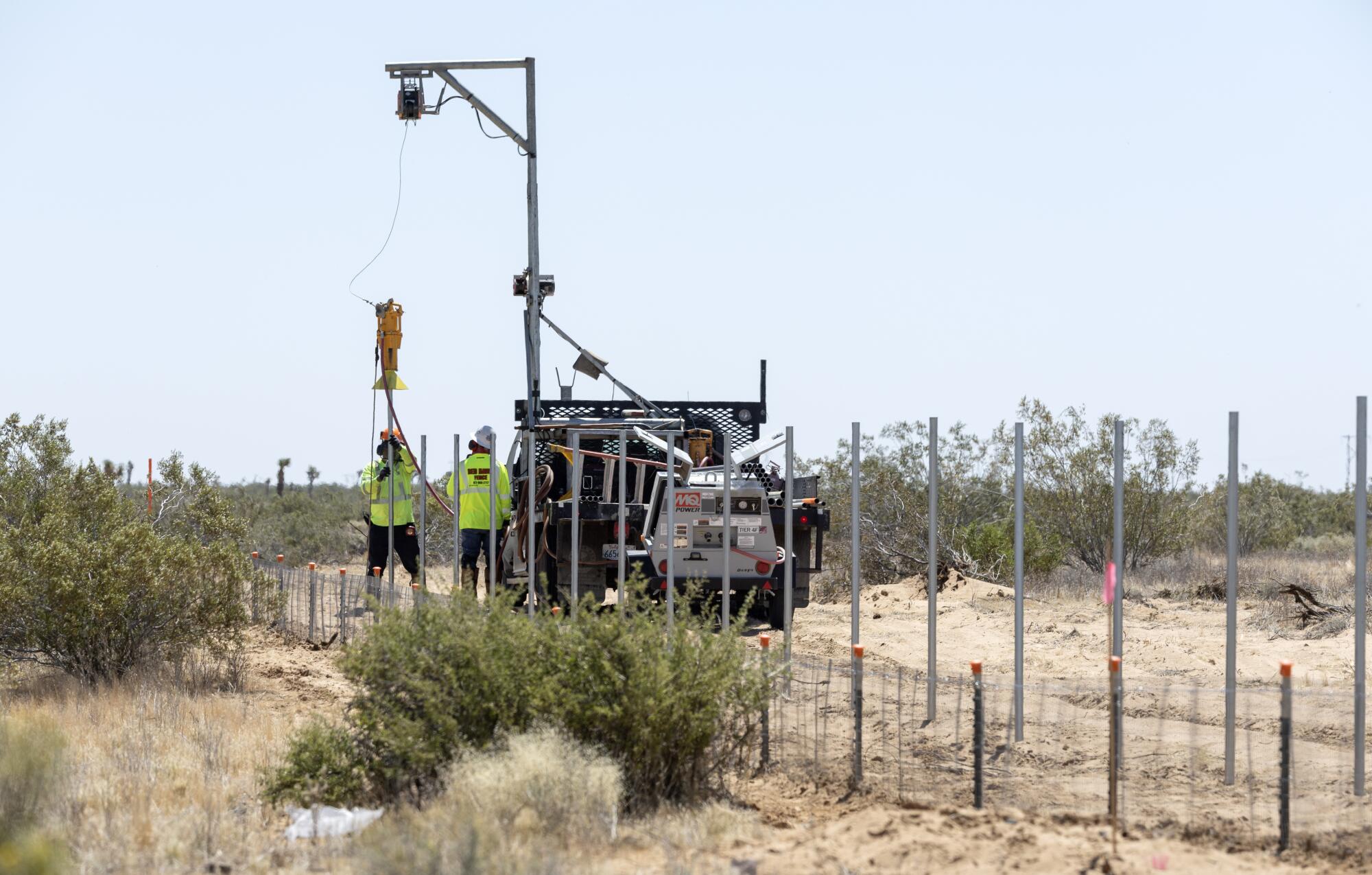
“Let’s destroy the environment to save the environment. That seems to be the mentality,” said Deric English, who teaches at Boron Junior-Senior High School. “It’s hard to comprehend.”
English was part of a group that found the fungus that causes valley fever in samples of soil from the five parcels surrounding the two towns where the solar panels will be built.
“How are kids going to be able to play outside?” asked Melanie Richardson, a nurse who has sons at schools near the site. “So many people from our community were begging them not to approve this project, and they passed it regardless.”
Aggressive and impactful reporting on climate change, the environment, health and science.
The controversy over the Mojave Desert project is an example of the trade-offs being made in California as state and local government officials press for a rapid expansion of clean energy. Although solar and wind fields are expected to help mitigate climate change, they are also tearing up undeveloped land, harming threatened plants and wildlife and causing concern in nearby communities, which are often small and far from the state’s cities.
“Rural communities that don’t have political power just get ramrodded over,” English said.
The site, known as the Aratina Solar Project, is being developed on private land by Avantus, a California company that is mostly owned by KKR, the global private equity firm.
Crews have been scheduled to start clearing the site of the iconic Joshua trees Monday, said a person who was briefed on the project. The person declined to be named since they were not authorized to discuss it.
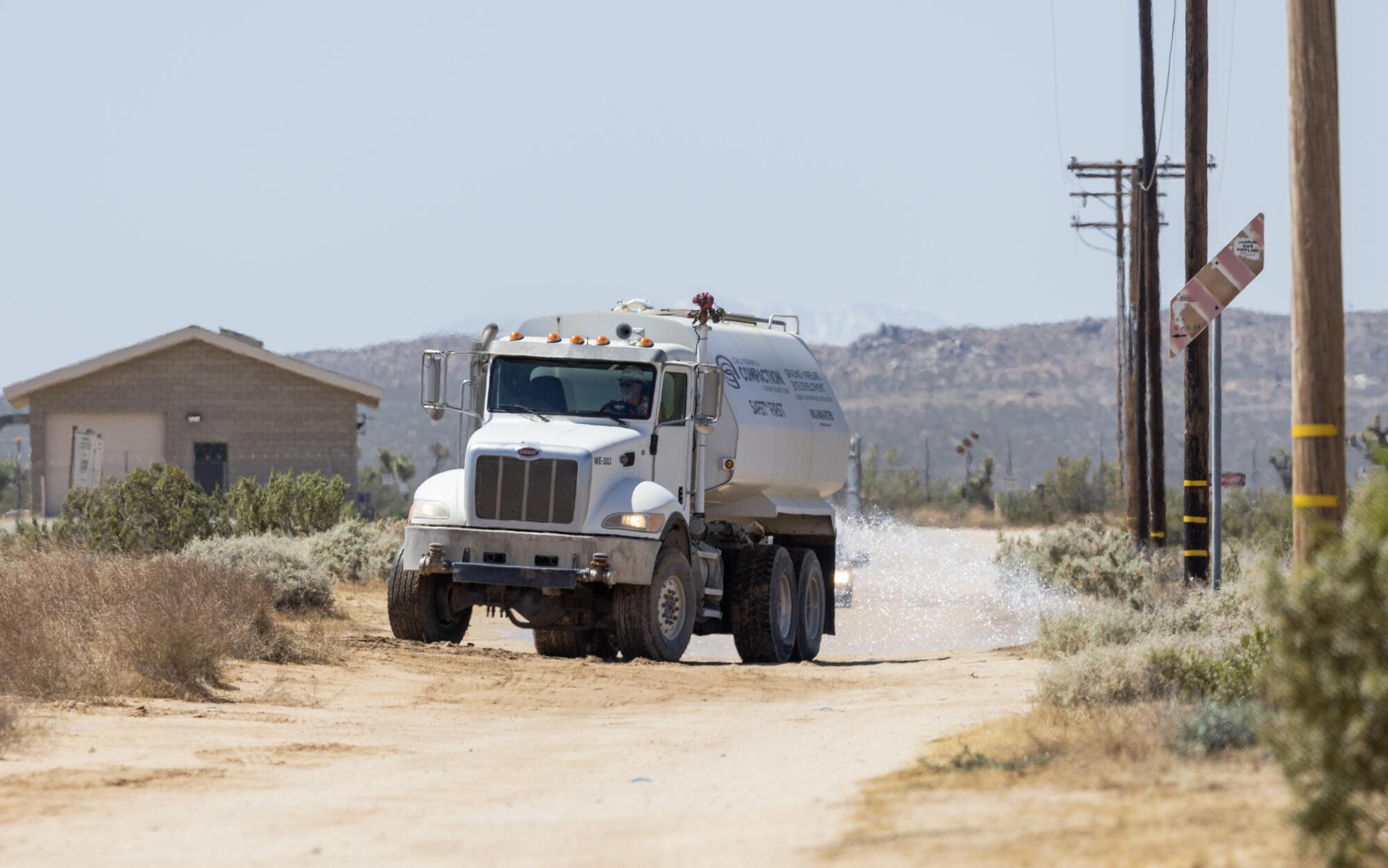
The company decided to take the extra step of shredding the trees onsite, rather than leaving them in piles or hauling them away whole, the person said, to reduce the visibility of the tree clearing.
Avantus executives would not confirm the June 3 date but said that the contractors had begun site preparations this month and “will soon begin selectively clearing the area of vegetation and other large natural obstacles” approved for removal by the county and state wildlife officials.
The company said the massive solar and battery storage project will have environmental benefits that outweigh the destruction of the Joshua trees and habitat of protected wildlife.
“While trees will be impacted during project construction, vastly more Joshua trees are being threatened by climate change caused by rising greenhouse gas emissions, which the Aratina solar project directly addresses,” the company says on its website.
“Avantus takes care on all projects to minimize any unnecessary impacts such as noise, dust, or traffic throughout all phases of the project,” the company told The Times in a statement. It added that it was “committed to being a good neighbor.”
America needs lots of clean power, fast. Should it go on public lands or on rooftops?
The Kern County Board of Supervisors unanimously approved the project in October 2021 despite comments and letters from dozens of residents.
“It was like the decision had already been made,” Richardson said.
Aratina will be the ninth solar project that Avantus, formerly named 8minute Solar, has built in Kern County.
During the board meeting, Alexander Sundquist, a company executive, said the benefits of the project to the county included $3 million in sales taxes and $73 million in property taxes.
When asked why the company decided to put the project on land next to the two towns, Sundquist said that executives wanted to keep the solar field in Kern County rather than farther south in San Bernardino. “We like doing business here,” he said.
In 2019, San Bernardino County Supervisors voted to ban the construction of large solar and wind farms on more than 1 million acres of private land.
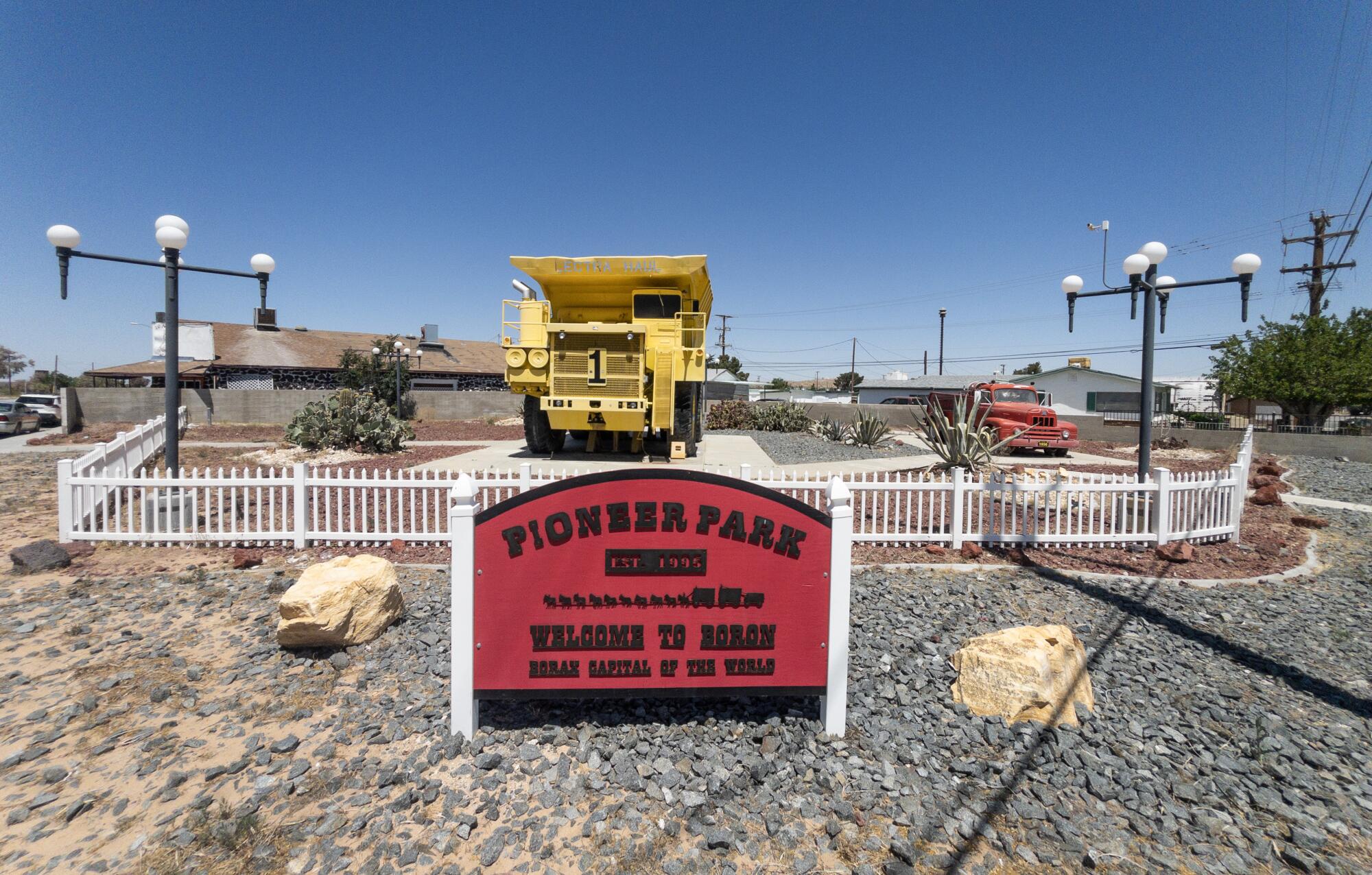
Kern County, home to the state’s largest oil patch, has long been friendly to energy companies. Lorelei Oviatt, director of Kern County Planning and Natural Resources, has repeatedly spoken at industry conferences to emphasize how the county tries to quickly approve projects.
Oviatt told The Times that so far the county has approved 160,000 acres of solar and wind energy projects. Most of those projects are in the desert, she said, because of the easier access there to electric transmission lines.
“I am pro Kern County not necessarily pro solar,” Oviatt said. “There was an over 18-month process and nothing was rushed. My recommendation (to approve the project) carefully considered all the community comments.”
“Land use is always a balance of private property rights and people’s viewpoints,” she said.
California has enacted the Western Joshua Tree Conservation Act, which is aimed at helping to ensure the survival of millions of the climate-threatened trees.
The county said that Avantus had put $1.4 million into a fund that will be used to protect Joshua trees in other areas of the state.
To mitigate the damage from Aratina and several other solar projects, Avantus has also purchased the grazing rights on 215,000 acres of federal land in Kern County and is working with government officials to preserve it.
Avantus declined to disclose the details of where the power would be sent. But earlier the company signed contracts to send some of the power to Silicon Valley Clean Energy and Central Coast Community Energy, nonprofit agencies that deliver green energy to homes in those regions .
“The generated energy doesn’t even stay here,” English said. “It’s shipped to other communities hundreds of miles away.”
Joshua trees, with their twisted, otherworldly shape, are often said to look like they were taken from the pages of a Dr. Seuss book. They grow just 1 to 3 inches a year, which means a 16-foot tree could be more than 100 years old.
The environmental impact statement for Aratina said that nearly 4,700 Joshua trees were found on the site during a survey. More than 500 of those trees are at least 16 feet tall.
“I’m not aware of other projects where this many trees will be removed,” said Kevin Emmerich of Basin and Range Watch, an environmental group.
Avantus agreed to reduce the project’s original footprint to create more space between the solar panels and the two communities. The person with knowledge of the project said the company’s plan now included destroying 3,500 Joshua trees.
Last year, state legislators passed the Western Joshua Tree Conservation Act, which bans unpermitted killing of the trees, while also providing a mechanism for the construction of green energy and housing projects.
The California Public Utilities Commission voted to fundamentally change how electricity is billed by adding a new monthly fixed fee.
State officials approved the Aratina project, however, before that law and before an earlier state decision to make the Joshua tree a candidate for protection under the California Endangered Species Act.
In 2020, the California Fish and Game Commission agreed that Aratina and 14 other green energy projects would not be subject to the increased measures to protect the tree.
Unfortunately, said Brendan Cummings, conservation director at the Center for Biological Diversity, “thousands of Joshua trees will be sacrificed.”
State wildlife officials told The Times that the company must still relocate any desert tortoises or Mohave ground squirrels, which are listed as threatened under California law, that are found during construction.
English said little attention has yet been paid to his group’s discovery on the site of the soil-dwelling fungus Coccidioides, which causes valley fever.
Valley fever has been found repeatedly to infect workers building solar fields in California.
On Thursday, half a mile from Boron’s Little League field, a construction crew, wearing yellow vests, was building a fence at the edge of the site, while a truck sprayed water, trying to keep the dust down.
Antje Lauer, professor of microbiology at Cal State Bakersfield, worked with English and Richardson to test the soil samples.
“Desert land is really cheap and there are not that many regulations,” Lauer said. “We need renewable energy, but it needs to be done correctly.”
Toward a more sustainable California
Get Boiling Point, our newsletter exploring climate change, energy and the environment, and become part of the conversation — and the solution.
You may occasionally receive promotional content from the Los Angeles Times.


